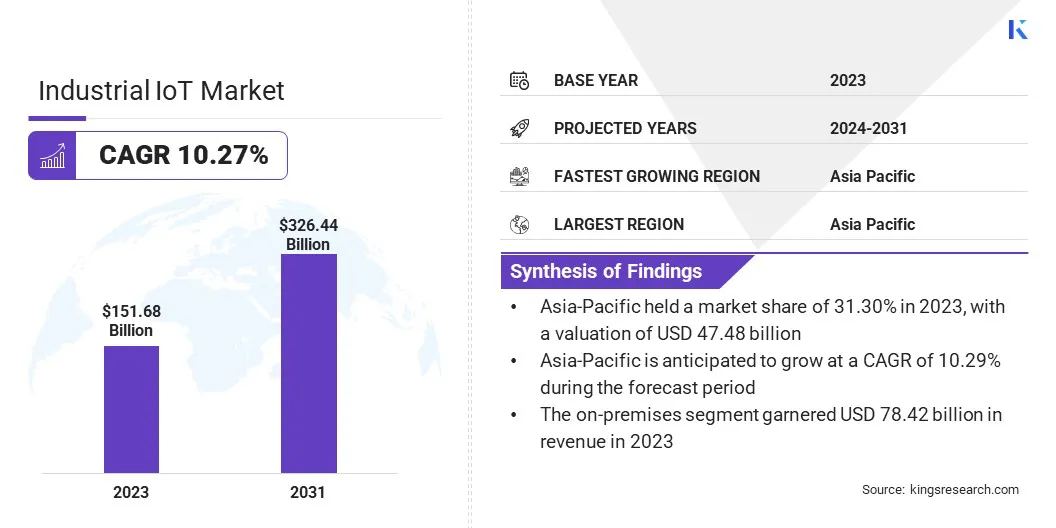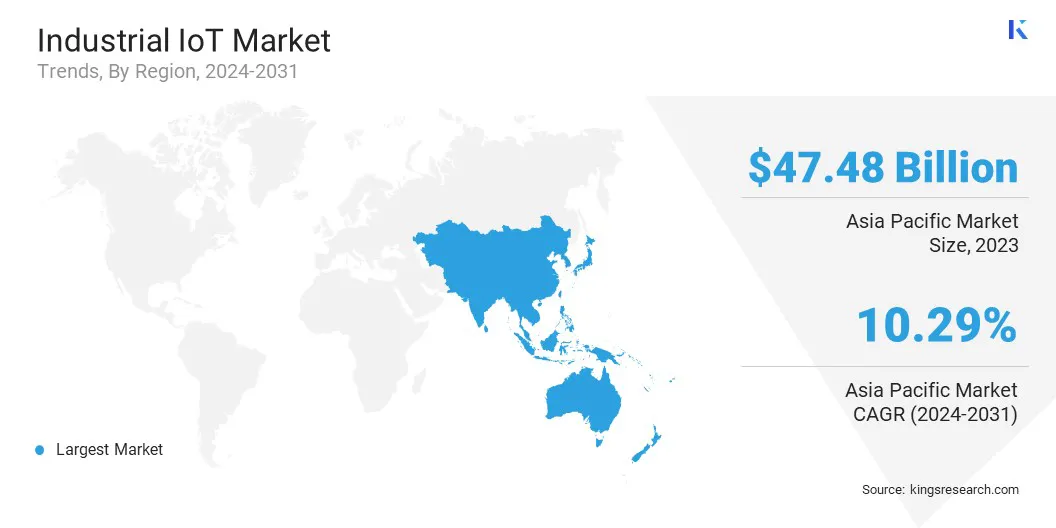Market Definition
The industrial IoT industry involves integrating IoT technologies into industrial environments, enabling machines, devices, and systems to connect, communicate, and share data for enhanced automation, optimization, and decision-making.
Covering sectors such as manufacturing, energy, transportation, and agriculture, it enhances efficiency, productivity, and cost-effectiveness through real-time data analytics and smart technologies.
Industrial IoT Market Overview
Global industrial IoT market size was USD 151.68 billion in 2023, which is estimated to be valued at USD 164.67 billion in 2024 and reach USD 326.44 billion by 2031, growing at a CAGR of 10.27% from 2024 to 2031.
The surging demand for automation in industries is boosting the growth of the market. By enabling real-time data collection, predictive maintenance, and smarter operations, IoT technologies help companies enhance productivity, reduce labor costs, and optimize efficiency.
Major companies operating in the industrial IoT market are ABB, Arm Limited, Cisco Systems, Inc, General Electric Company, Intel Corporation, International Business Machines Corporation (IBM), Microsoft, Rockwell Automation, Schneider Electric, Siemens, NEC Corporation, KUKA AG, Huawei Technologies Co., Ltd, Robert Bosch GmbH, Emerson Electric Co., and others.
The market is a dynamic and rapidly expanding sector, fueled by the integration of advanced technologies across industries. It spans diverse sectors, including manufacturing, energy, transportation, and agriculture, facilitating enhanced operational performance and streamlined processes.
The market is characterized by the growing adoption of connected devices, real-time data analytics, and intelligent systems that drive automation, optimize productivity, and improve overall efficiency in industrial environments.
- In January 2025, Accenture, NVIDIA, and KION Group introduced the "Mega" Omniverse Blueprint, leveraging IIoT technologies such as AI-driven digital twins and sensor simulations to optimize industrial operations, enhance productivity, and enable real-time decision-making.

Key Highlights:
- The industrial IoT industry size was recorded at USD 151.68 billion in 2023.
- The market is projected to grow at a CAGR of 10.27% from 2024 to 2031.
- Asia Pacific held a share of 31.30% in 2023, valued at USD 47.48 billion and is anticipated to grow at a CAGR of 10.29% over the forecast period.
- The software segment garnered USD 60.56 billion in revenue in 2023.
- The on-premises segment is expected to reach USD 168.54 billion by 2031.
- The small and medium enterprises segment is anticipated to grow at a CAGR of 10.28% through the projection period.
- The manufacturing segment captured a substantial share of 24.87% in 2023.
Market Driver
"Improved Connectivity (5G)"
The rollout of 5G networks is a contributing significantly to the growth of the industrial IoT market, providing faster and more reliable connectivity for IoT devices.
- According to the Press Information Bureau (PIB) in November 2024, India is at the forefront of 5G adoption, achieving over 90% coverage and enhancing accessibility through affordable services. Worldwide, 5G adoption is accelerating, and projections indicating that 5G subscriptions will surpass 4G by 2027.
With 5G’s low latency and high bandwidth capabilities, industrial systems can transmit vast amounts of data in real time, enabling seamless communication between devices and improving automation, efficiency, and decision-making.
This advanced connectivity supports more complex and scalable industrial IoT applications, including remote monitoring, predictive maintenance, and smart manufacturing, boosting the adoption of industrial IoT solutions across industries.
- In July 2024, KORE, a global IoT solutions leader, partnered with mCare Digital to launch the mCareWatch 241, a personal emergency alarm. By leveraging IoT connectivity, KORE enables seamless patient monitoring in home and healthcare facilities.
Market Challenge
"Shortage of Skilled Workers"
A key challenge impeding the growth of the industrial IoT industry is the shortage of skilled professionals in data analytics, AI, and IoT technologies, which can impede effective deployment and operation. To address this challenge, companies are investing in comprehensive training programs, partnerships with educational institutions, and upskilling initiatives.
Additionally, leveraging automated tools and user-friendly platforms can reduce dependence on specialized expertise, while promoting a more accessible and adaptable workforce for IoT adoption.
- In October 2024, Google.org allocated USD 15 million to enhance AI skills among U.S. government workers. This initiative, in collboration with the Partnership for Public Service and InnovateUS, supports the market’s need for skilled professionals to advance AI and IoT advancements in public services.
Market Trend
"Integration of AI and Machine Learning"
The integration of AI and machine learning has emerged as a key trend in the industrial IoT market, significantly transforming manufacturing and operations. By leveraging AI/ML, industries are enhancing predictive maintenance, reducing downtime, and optimizing processes for greater efficiency.
Advanced data analytics powered by AI enables real-time insights, optimizing decision-making, improving product quality, and minimizing operational costs. As AI and ML algorithms evolve, their integration into industrial IoT systems fosters innovations, enhances automation, and creates more agile, responsive industrial environments.
- In December 2024, Samsung's C-Lab startups, featuring advancements in AI, IoT, digital health, and robotics, will showcase innovative solutions at CES 2025. These projects, including AI-driven solutions and smart IoT systems, highlight the IoT's growing role in transforming industries and enhancing operational efficiencies.
Industrial IoT Market Report Snapshot
| Segmentation |
Details |
| By Component |
Hardware, Software (Remote Monitoring, Data Management, Analytics, Real-Time Streaming Analytics, Security Solutions, Others), Services (Managed, Professional) |
| By Deployment |
Cloud-based, On-Premises |
| By Organization |
Small and Medium Enterprises, Large Enterprises |
| By Vertical |
BFSI, Government, Healthcare, Manufacturing, Transportation, Others |
| By Region |
North America: U.S., Canada, Mexico |
| Europe: France, U.K., Spain, Germany, Italy, Russia, Rest of Europe |
| Asia-Pacific: China, Japan, India, Australia, ASEAN, South Korea, Rest of Asia-Pacific |
| Middle East & Africa: Turkey, UAE, Saudi Arabia, South Africa, Rest of Middle East & Africa |
| South America: Brazil, Argentina, Rest of South America |
Market Segmentation:
- By Component (Hardware, Software, and Services): The software segment earned USD 60.56 billion in 2023, mainly due to the increasing demand for data analytics, cloud solutions, and IoT-enabled software applications enhancing operational efficiencies across industries.
- By Deployment (Cloud-based and On-Premises): The on-premises segment held a share of 51.70% in 2023, as enterprises prioritized control, data security, and compliance,particularly in sensitive environments such as manufacturing and critical infrastructure.
- By Organization (Small and Medium Enterprises and Large Enterprises): The large enterprises segment is projected to reach USD 182.97 billion by 2031, supported by significant investments in advanced IoT solutions for automation, data-driven decision-making, and supply chain optimization.
- By Vertical (BFSI, Government, Healthcare, Manufacturing, Transportation, and Others): The BFSI segment is anticipated to grow at a CAGR of 10.30% through the forecast period, attributed to increasing adoption of IoT technologies for improving customer experiences, fraud detection, and operational efficiency.
Industrial IoT Market Regional Analysis
Based on region, the market has been classified into North America, Europe, Asia-Pacific, MEA, and Latin America.

The Asia-Pacific industrial IoT market captured a notable share of around 31.30% in 2023, valued at USD 47.48 billion. This dominance is reinforced by rapid digital transformation across industries such as manufacturing, healthcare, and transportation.
The region’s strong focus on smart city initiatives, automation, and government-backed investments in IoT technologies has further bolstered this growth. Additionally, the increasing adoption of 5G, along with a growing manufacturing sector, is accelerating IoT deployment, making Asia Pacific a hub for innovation and a key region in the global industrial IoT landscape.
- In July 2024, Cisco and Rockwell Automation partnered to accelerate digital transformation in Asia Pacific's industrial market. By integrating IoT and automation solutions, the collaborations aims to enhance productivity, secure networks, and address the digital skills gap in manufacturing.
Europe industrial IoT industry is set to grow at a CAGR of 10.28% through the estimated timeframe. This rapid growth is stimulated by strong government initiatives and the increasing demand for automation and digital transformation in manufacturing.
The adoption of IoT technologies in industries such as manufacturing, energy, and transportation is rising due to advancements in connectivity, AI, and data analytics. European companies are focusing on enhancing operational efficiency, sustainability, and security, fostering innovation and investment in industrial IoT solutions.
Region’s Regulatory Framework Also Plays a Significant Role in Shaping the Market
- In the U.S., the NIST Cybersecurity Framework helps businesses of all sizes better understand, manage, and reduce their cybersecurity risk and protect their networks and data
- With the General Data Protection Regulation (GDPR) underscores Europe's commitment to data privacy and security amid rising cloud data reliance and frequent breaches.
- The EU Cybersecurity Act establishes a unified cybersecurity certification framework for ICT products, services and processes across the EU. Businesses operating in the region can certify their ICT offerings once, with certifications recognized throughout the European Union.
Competitive Landscape:
The industrial IoT industry is characterized by a large number of participants, including both established corporations and rising organizations.
Key players are forming strategic partnerships to leverage technology, expertise, and resources. These collaborations enhance product offerings, foster innovation, improve operational efficiency, and accelerate market penetration. By combining capabilities, companies aim to drive growth and meet evolving industry demands.
- In November 2024, Eseye partnered with Sateliot to provide global IoT connectivity solutions using advanced LPWAN satellite technology. The collaboration enables seamless multi-RAT connectivity, extending IoT services beyond terrestrial networks, ensuring reliable connectivity in remote areas and enhancing industrial and urban IoT deployments globally.
List of Key Companies in Industrial IoT Market:
- ABB
- Arm Limited
- Cisco Systems, Inc
- General Electric Company
- Intel Corporation
- International Business Machines Corporation (IBM)
- Microsoft
- Rockwell Automation
- Schneider Electric
- Siemens
- NEC Corporation
- KUKA AG
- Huawei Technologies Co., Ltd
- Robert Bosch GmbH
- Emerson Electric Co.,
Recent Developments (Partnerships/New Product Launch)
- In April 2024, Margo, an open standard initiative under the Linux Foundation, was launched to enhance interoperability in Industrial IoT ecosystems. Backed by major automation solution providers, including ABB, it aims to simplify digital transformation by enabling seamless collaboration between applications, devices, and edge orchestration software.
- In October 2024, Rockwell Automation advanced its FactoryTalk Optix portfolio for Industrial IoT with DataReady smart machines. This update enhances data collection, contextualization, and seamless integration with cloud applications, optimizing industrial operations, and enabling real-time insights for enhanced production efficiency.
- In July 2023, Honeywell acquired SCADAfence to enhance its cybersecurity software portfolio. SCADAfence’s OT and IoT security solutions were integrated into Honeywell Forge Cybersecurity+, enhancing threat detection, asset discovery, and compliance management across industrial networks.
- In February 2023, Cisco introduced new cloud services in its IoT Operations Dashboard, enhancing industrial asset visibility and securing remote management. Innovations such as Cisco Cyber Vision integration and ThousandEyes for OpenTelemetry empower IT and OT teams to optimize operations and cybersecurity across networks.
- In June 2023, Ayla Networks announced its IoT platform as the foundation for etisalat by e&'s high-end smart home solution. This partnership integrates top brands, providing seamless management via a unified smart living app, offering flexibility, security, and future-proof compatibility with Matter.
- In November 2023, AWS introduced AWS IoT SiteWise Edge on Siemens Industrial Edge Marketplace (Preview), enabling faster, cost-effective industrial equipment data transfer to the AWS cloud. This solution simplifies deployment, supports predictive maintenance, asset monitoring, and improved operational efficiency.


